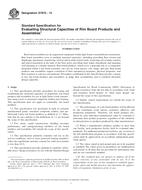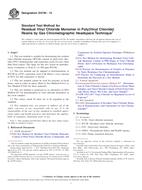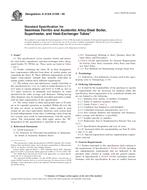1.1 This test method covers several ground penetrating radar (GPR) evaluation procedures that can be used to evaluate the condition of concrete bridge decks overlaid with asphaltic concrete wearing surfaces. These procedures can also be used for bridge decks overlaid with portland cement concrete and for bridge decks without an overlay. Specifically, this test method predicts the presence or absence of concrete or rebar deterioration at or above the level of the top layer of reinforcing bar.
1.2 Deterioration in concrete bridge decks is manifested by the corrosion of embedded reinforcement or the decomposition of concrete, or both. The most serious form of deterioration is that which is caused by corrosion of embedded reinforcement. Corrosion may be initiated by deicing salts, used for snow and ice control in the winter months, penetrating the concrete. In arid climates, the corrosion can be initiated by chloride ions contained in the mix ingredients. Deterioration may also be initiated by the intrusion of water and aggravated by subsequent freeze/thaw cycles causing damage to the concrete and subsequent debonding of the reinforcing steel with the surrounding compromised concrete.
1.2.1 As the reinforcing steel corrodes, it expands and creates a crack or subsurface fracture plane in the concrete at or just above the level of the reinforcement. The fracture plane, or delamination, may be localized or may extend over a substantial area, especially if the concrete cover to the reinforcement is small. It is not uncommon for more than one delamination to occur on different planes between the concrete surface and the reinforcing steel. Delaminations are not visible on the concrete surface. However, if repairs are not made, the delaminations progress to open spalls and, with continued corrosion, eventually affect the structural integrity of the deck.
1.2.2 The portion of concrete contaminated with excessive chlorides is generally structurally deficient compared with non-contaminated concrete. Additionally, the chloride-contaminated concrete provides a pathway for the chloride ions to initiate corrosion of the reinforcing steel. It is therefore of particular interest in bridge deck condition investigations to locate not only the areas of active reinforcement corrosion, but also areas of chloride-contaminated and otherwise deteriorated concrete.
1.3 This test method may not be suitable for evaluating bridges with delaminations that are localized over the diameter of the reinforcement, or for those bridges that have cathodic protection (coke breeze as cathode) installed on the bridge or for which a conductive aggregate has been used in the asphalt (that is, blast furnace slag). This is because metals are perfect reflectors of electromagnetic waves, since the wave impedances for metals are zero.
1.4 A precision and bias statement has not been developed at this time. Therefore, this standard should not be used for acceptance or rejection of a material for purchasing purposes.
1.5 The values stated in SI units are to be regarded as the standard. The inch-pound units given in parentheses are for information only.
1.6 This standard does not purport to address all of the safety concerns, if any, associated with its use. It is the responsibility of the user of this standard to establish appropriate safety and health practices and determine the applicability of regulatory limitations prior to use. Specific precautionary statements are given in Section 5.
Product Details
- Published:
- 07/01/2008
- Number of Pages:
- 6
- File Size:
- 1 file , 88 KB
- Redline File Size:
- 2 files , 180 KB


